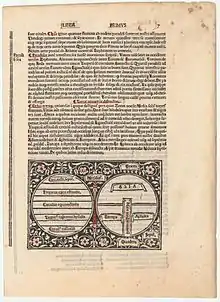Giacomo Filippo Foresti
Giacomo Filippo Foresti da Bergamo[1] (1434–1520) was an Augustinian friar,[2] known as the author of several significant early printed works. He was a chronicler and Biblical scholar.

_Foresti_(1434-1520)_dit_%22Philippe_de_Bergame%22.png.webp)

His Supplementum chronicarum (first printed at Venice, 1483)[3] was a supplement to the usual universal chronicle; it ran to numerous subsequent editions. Though it mixes mythological figures, treated euhemeristically as historical ones, on an equal footing with Christian cultural heroes, with additional chapters on the Sibyls and the Trojan War,[4] amongst other things, it was thought to contain Giovanni da Carignano's lost work on papal contacts at Avignon in 1306 with Ethiopian visitors.[5] Recent research has both drawn attention to the Legenda Aurea and the letter of Prester John as possible sources for Foresti's narration of the episode, casting doubt on the veracity of an Ethiopian embassy to Europe at this date,[6] as well as a section in the Cronica Universalis of Galvano Fiamma, indicating conversely that this section of Foresti's account is entirely and directly based, to exclusion of other sources, on the cartographic treatise of Giovanni da Carignano.[7]
His De claris mulieribus[8] updated the work of Boccaccio of the same title. It was dedicated to Beatrice of Aragon.[9] This book, as well as the Supplementum, influenced many subsequent publications.
He also wrote a well-known confessional.
Works

- Supplementum chronicarum, Bernardino Benali, Venice 1483
- De plurimis claris selectisque mulieribus, Lorenzo de Rubeis, Ferrara 1497
- Confessionale seu interrogatorium (in Italian). Venice: Alessandro Bindoni. 1520.
Notes
- Also known as: Giacomo Filipo Foresti, Giacomo Filippo da Bergamo, Jacobus Filippus Foresti, Jacobus Philippus Foresti (da Bergamo), Jacopo Filippo Foresta, Jacobus Philippus de Bergamo, Jacobus Philippus Bergomensis, Iacobus Philippus Bergomensis, Forestus Bergomensis, Jacopo da Bergamo, Jacopo Filippo Foresti da Bergamo, Jacopo de Foresti, Jacob Philip of Bergamo.
- "Incunabula Leaves from Italy | Incunabula - Dawn of Western Printing". Archived from the original on 2013-03-07. Retrieved 2007-01-26.
- Page Archived 2006-09-27 at the Wayback Machine; in Latin, translated into Italian as Supplemento delle Croniche in 1491 .
- Noted by Jean Seznec, The Survival of the Pagan Gods, (B.F. Sessions, tr.) 1995:21.
- See Encounters
- See Krebs, Verena (2019). Re-examining Foresti’s Supplementum Chronicarum and the “Ethiopian” embassy to Europe of 1306. Bulletin of the School of Oriental and African Studies, 82/3, 493-515. https://doi.org/10.1017/S0041977X19000697
- See Chiesa, Paolo (2018). Galvano Fiamma e Giovanni da Carignano. Una nuova fonte sull’ambasceria etiopica a Clemente V e sulla spedizione oceanica dei fratelli Vivaldi. Itineraria, 17 (2018), 63–107; Bausi, Alessandro and Paolo Chiesa (2019). The Ystoria Ethyopie in the Cronica Universalis of Galvaneus de la Flamma (d. c.1345). Aethiopica, 22, 7–57. https://doi.org/10.15460/aethiopica.22.0.1491
- Page; On famous women; later under other titles De claris selectisque plurimis mulieribus, De memorabilibus et claris mulieribus aliquot diversorum scriptorum opera.
- Archived 2018-10-19 at the Wayback Machine; Queen of Hungary as wife to Matthias Corvinus, see de:Beatrix von Aragón.